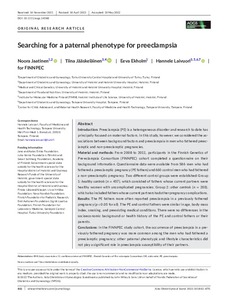Searching for a paternal phenotype for preeclampsia
Jääskeläinen Tiina; Laivuori Hannele; for FINNPEC; Ekholm Eeva; Jaatinen Noora
https://urn.fi/URN:NBN:fi-fe2022091258576
Tiivistelmä
Introduction Preeclampsia (PE) is a heterogeneous disorder and research to date has principally focused on maternal factors. In this study, however, we considered the associations between background factors and preeclampsia in men who fathered preeclamptic and non-preeclamptic pregnancies.
Material and methods From 2008 to 2011, participants in the Finnish Genetics of Pre-eclampsia Consortium (FINNPEC) cohort completed a questionnaire on their background information. Questionnaire data were available from 586 men who had fathered a preeclamptic pregnancy (PE fathers) and 660 control men who had fathered a non-preeclamptic pregnancy. Two different control groups were established: Group 1: healthy controls (n = 457), which consisted of fathers whose current partners were healthy women with uncomplicated pregnancies; Group 2: other controls (n = 203), which also included fathers whose current partners had other pregnancy complications.
Results The PE fathers more often reported preeclampsia in a previously fathered pregnancy (p < 0.05 for all). The PE and control fathers were similar in age, body mass index, smoking, and preexisting medical conditions. There were no differences in the socioeconomic background or health history of the PE and control fathers or their parents.
Conclusions In the FINNPEC study cohort, the occurrence of preeclampsia in a previously fathered pregnancy was more common among the men who had fathered a preeclamptic pregnancy; other paternal phenotypic and lifestyle characteristics did not play a significant role in preeclampsia susceptibility of their partners.
Kokoelmat
- Rinnakkaistallenteet [19204]
